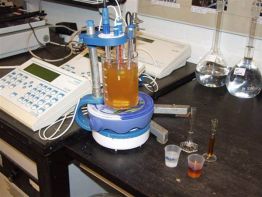Project Aim
“Development of the best environmental practice for decontaminating Tributyltin (TBT) containing waters in the North Sea Region based on Life Cycle Assessment”
The main aim of the Green-NSD project was to develop a common decision supporting tool (DST) in transnational co-operation between EPAs, harbour administrations and scientists in order to provide decision makers an instrument for sustainable management of the marine environment.
Project implementation and results
Activities
One of the first steps to reach the aim of a sustainable management of the marine environment was the testing of innovative technologies for water treatment in dockyards. During the project implementation of new applications (removal of Cu, Zn and TBT) were found for commercially available sorbents.
Innovative solutions
The main achievement of the project was the development of a Green North Sea Docks decision-support tool (DST). The DST is a tool developed to assists dockyard environmental managers and environmental protection administrations. Therefore an assessment strategy which introduced elements of the concept of sustainability to compare alternative treatment processes, i.e. the environmental assessment based on a life-cycle approach and eco-toxicological tests were carried out.
The outcome was that considering a wide range of environmental impacts caused by treatment process is an innovative way of assessing environmental problems in the dockyard sector. That had a large value for planning technological improvements to existing operation or treatment technologies.
Joint transnational strategy
Mode of cooperation
Green-NSD has fostered an exchange of knowledge on scientific level and has presented the outcomes of the project to stakeholders in and outside the North Sea Region.
The decision-support tool was conceived as a tool to compare alternative processes under different scenarios following the concept of transnationality. This means that any stakeholder in the region can use it according his context, e.g. regulation of discharge criteria, costs and transport of raw materials, energy costs, etc.
Impact of the project
Long term achievements
A key of the success of the Green-NSD project was its innovative character. Although adsorption is a well-established technology in the water treatment, this is not frequently used in dockyards. In this project new applications (removal of Copper, Zinc and Tributyltin) were found for commercially available sorbents. Photolysis (UV-treatment) is already implemented in some countries: the USA and Germany but it does not find widespread use in the dockyard sector yet. On the other hand, electrochemical treatment is an innovative technology that is not implemented in the dockyard sector yet. The findings of the project suggest that it has the potential of being an attractive technology to treat heavily contaminated waters.
Policy shaping
The results of the environmental assessment based on life-cycle assessment and eco-toxicological tests were used by the Working Committee of Wastewaters from Dockyards in Germany for setting eco-toxicological criteria for dockyards in the new German Water Ordinance. |

Removal of copper and zinc from dockyard wastewaters by flocculation and filtration
Partners Interdisciplinary Research Centrum KULAK, BE
Flemish Government - Agency for Maritime and Coastal Services - Division Coast, BE
Danish Technical University, DK
TU-Technology GmbH, DE
Umweltbehörde Hamburg, BUG, DE
Der Senator für Bau, Umwelt und Verkehr, DE
Norwegian Geotechnical Institute, NO
County Administration of Västra Götaland, SE
Göteborg University, SE
Västerhavet Association, SE
LP:
Technical University Hamburg-Harburg
Project Manager
W. Calmano
Technical University Hamburg-Harburg
Eissendorfer Strasse 40
D-21073 Hamburg
Germany
calmano@tu-harburg.de
www.greendocks.de
Tel: +49 40 42878 3108
Measure: 1.5
Start Date: 30 September 2002
End Date: 30 December 2005
ERDF Grant:
 411.000,00 411.000,00
Total Eligible Sum:
 822.000,00 822.000,00
|